|
Tying Steps:

1. Start the thread and tie in a tail of red hackle fibers.
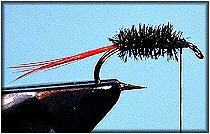
2. Wrap a peacock herl body as shown.
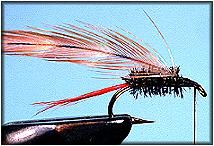
3. Tie in the hackle, curvature down and back.
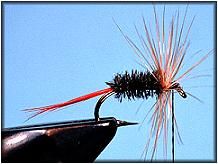
4. Make two or three wraps of the hackle and tie off. (If you're using
cheap hackle, this is about all the wraps you'll get anyway. The
feathers are usually too short to support anything more.)
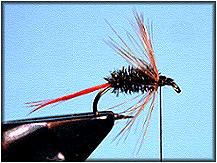
5. Pull the hackle back and wrap thread over the front part of it to
give the hackle a slight sweep.
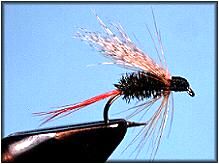
6. Add a mallard flank feather wing as shown. Try not to use too
much or too little wing. This is about the right amount. When the wing
is attached, make a smooth head, whip finish, trim and cement your
knot.
Fishing the Deerfield Special:
A lot of aquatic insects put effort into the swim to the water's
surface. They swim to the surface, deflect off and swim back at it
again. Sometimes this swimming action is across the current,
sometimes it's with the current and sometimes it's against the current.
That's why you can often fish a wet fly in many different fashions and
achieve good results.
The classic wet fly swing is used to imitate active emergers. You
cast across the current, let the fly sink a little, tighten the line and let
the fly swing toward the surface, and twitch the rod tip to look like an
emerger that is pounding on the surface tension trying to break
through. Dead drifting and pulling the fly across or against the current
also work quite well. This is the time when aquatic insect life is the
most vulnerable. The fish know it and look for signs of an emerging
insect. Fish usually take wet flies with an aggressive bite.
~ Al Campbell
(Chat Room Host AC)
For more great flies, check out:
Beginning Fly Tying and
Intermediate Fly Tying.
|







